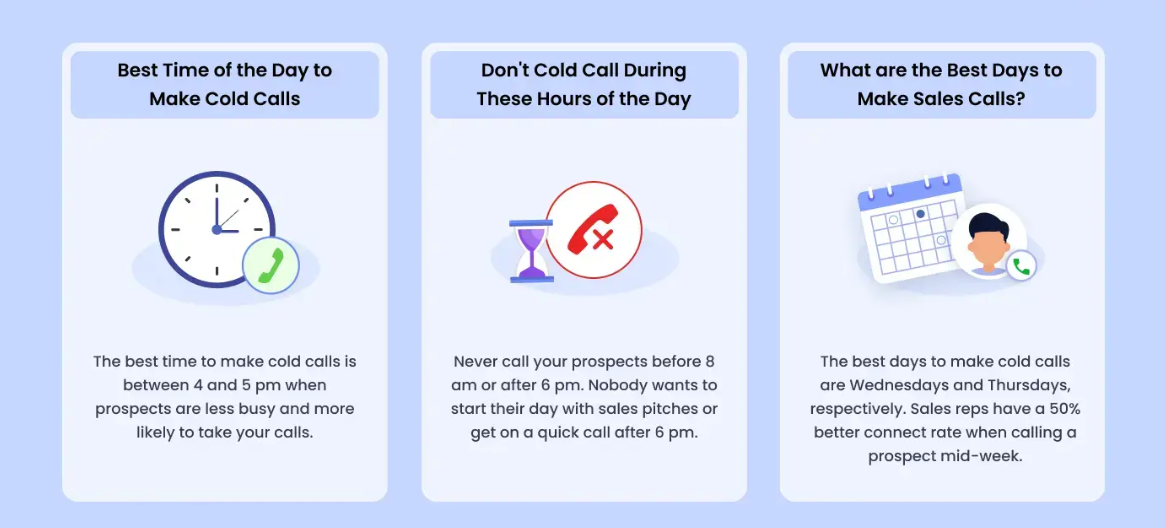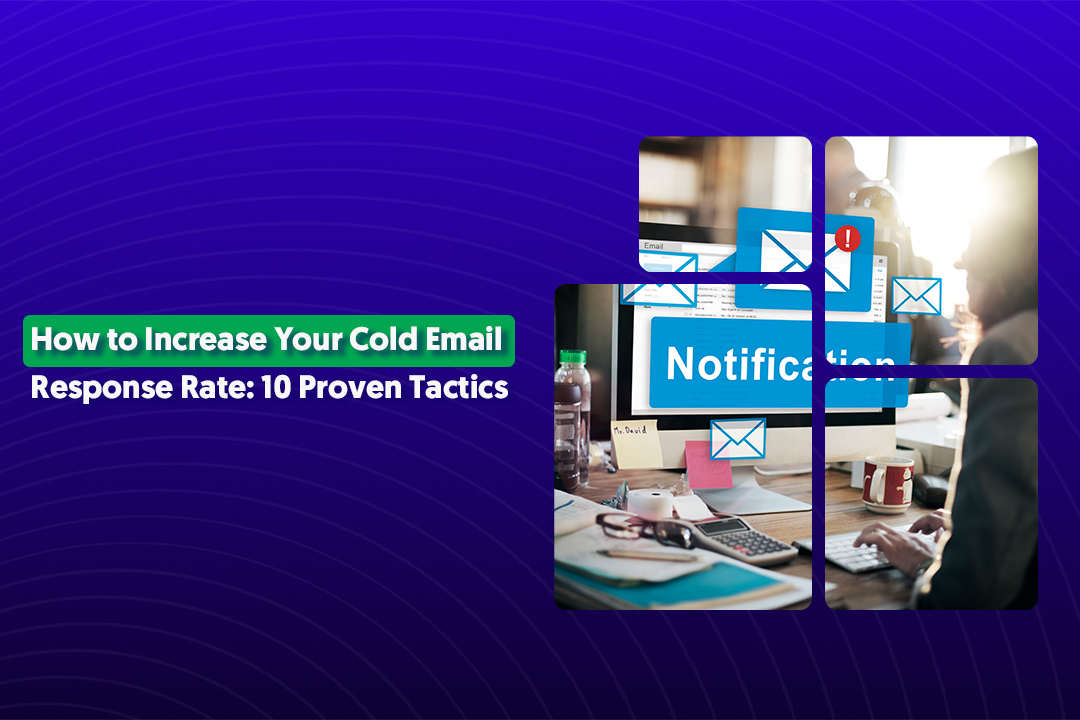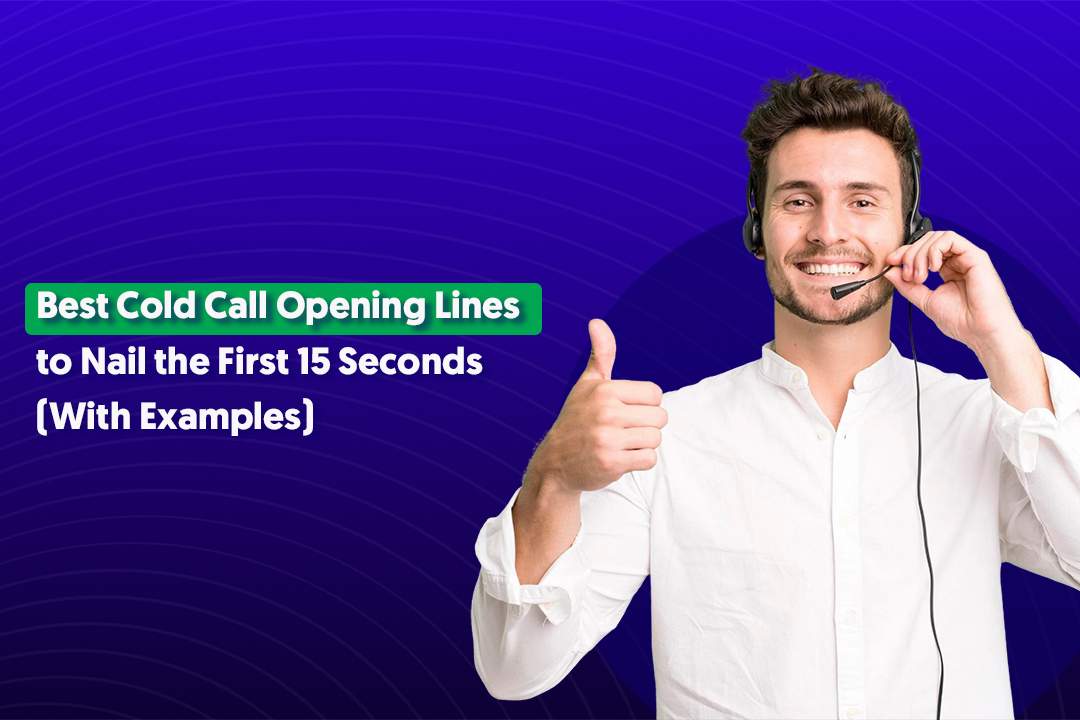Table of Content
Key Takeaways
- Cold calling has evolved with data-driven targeting and personalization, delivering 2–5% conversion rates in 2025.
- It takes an average of 8 call attempts to reach a decision-maker, and most reps quit too early.
- Midweek afternoons between 4–5 p.m. in your prospect's time zone yield the best results.
- Effective coaching can boost conversion rates by 38% and revenue per rep by 50%.
- 50–60% of B2B buyers still prefer phone contact, making cold calling a critical channel in your outreach strategy.
- The future belongs to teams combining smart automation with genuine conversations.
You've probably heard it a thousand times: "Cold calling lead gen is dead." But here's the thing, the data tells a completely different story.
Cold calling statistics from 2025 show that this channel isn't just alive, it's still one of the most effective ways to reach decision-makers in B2B sales.
In this guide, we're cutting through the noise and sharing actual cold calling statistics that matter. You'll see real success rates, response benchmarks, and insights from leading industry studies.
Whether you're running an SDR team, outsourcing your outreach, or handling calls yourself, these stats will give you a clear picture of where you stand and what's possible.
Let's look at the data that separates successful cold callers from the rest.
Why Cold Calling Still Works in 2025
Cold calling has surely evolved. The spray-and-pray approach? Yeah, that's dead. But targeted, research-backed cold calling is thriving in 2025.
Here's what's changed: successful cold callers now combine personalization with timing and multi-channel strategies.
The cold calling success statistics back this up. Companies using data-driven targeting and personalized messaging see significantly higher connection rates and conversion rates than those still using outdated tactics.
Why it works now:
- Direct access to decision-makers – Email inboxes are flooded, but a phone call still cuts through.
- Real-time conversations – You get immediate feedback and can pivot your pitch on the spot.
- Higher trust factor – Voice conversations build rapport faster than text-based outreach.
- Integration with other channels – Cold calls work best when paired with LinkedIn outreach and follow-up emails.
The key difference in 2025? Quality over quantity.
Successful cold calling lead generation now relies on solid targeting, relevant messaging, and reps who actually understand their prospect's pain points before they pick up the phone.
Cold Calling Success Rates & Conversion Benchmarks
Let's talk numbers. If you're wondering what "good" looks like in cold calling success statistics, here's what the data shows for 2025.
Average Cold Calling Conversion Rate
The typical cold call conversion rate sits between 2–3%. That means out of every 100 calls, you're looking at roughly 2 to 3 conversions into qualified opportunities or next steps.
Is that low? Not really. When you factor in that you're reaching people who've never heard of you before, a 2–3% conversion rate is actually solid.
The key is volume plus targeting—hit the right prospects consistently, and those percentages add up fast.
Average Calls Needed to Reach a Decision-Maker
Here's a reality check: it takes an average of 8 call attempts to finally connect with a prospect. Most reps give up after 2 or 3 tries, which is exactly why persistence matters.
The best b2b cold calling teams build this into their cadence. They're not hoping to catch someone on the first dial—they're planning for multiple touches across different days and times.
Percentage of Cold Calls That Lead to a Meeting
Cold calling statistics show that meeting rates typically fall between 1% and 3%. So if you're making 100 calls, expect to book 1 to 3 meetings on average.
This is where quality targeting makes a huge difference. Teams that research their prospects and personalize their approach tend to land on the higher end of that range.

ROI Benchmarks for Cold Calling Campaigns
A strong cold calling campaign should target a 1% to 5% conversion rate from call to meeting or sale. If you're hitting 5% or above, you're in the top tier.
These benchmarks give you a realistic goal to aim for. The teams crushing it aren't necessarily making more calls, they're making smarter calls with better targeting and tighter messaging.
B2B Cold Calling Statistics You Should Know
B2B cold calling statistics paint a clear picture: the phone isn't going anywhere. In fact, it's still the preferred channel for a huge chunk of decision-makers.
B2B Buyers Still Want Phone Calls
Here's something that might surprise you: 50–60% of B2B buyers still prefer phone contact during the sales process.
This isn't about being old-school. It's about efficiency. A 10-minute call can cover what would take dozens of emails back and forth.
Industry-Specific Cold Calling Performance
Not all industries respond to cold calling the same way. Here's how conversion rates break down across sectors:
If you're in tech or SaaS, don't get discouraged by that 0.95%. It just means you need tighter targeting and more touches. Business services and consulting naturally convert higher because buying cycles are often shorter.
Cold Calling vs. LinkedIn vs. Email
Let's compare apples to apples. Here's how different b2b cold calling channels stack up:
- LinkedIn outreach: 12–18% conversion from lead to opportunity, with reply rates between 10–25%.
- Cold email: 1–5% conversion rate.
- Cold calling: 2–5% conversion rate.
LinkedIn gets you higher reply rates, but those replies don't always mean qualified interest.
Cold calls and emails perform similarly for conversions, but calls give you real-time qualification. The smartest approach? Use all three together.
A LinkedIn connection request, followed by an email, then a call—that's how you break through in 2025.
Compare: Cold Calling vs Cold Emailing: What's Best for B2B Sales
Cold Calling Productivity & Efficiency Stats
Knowing the right cold call statistics around timing and volume can completely change your results. Here's what actually moves the needle.
Best Days and Times to Make Cold Calls
What's the best time to cold call? The data is pretty clear: midweek afternoons work best, specifically between 4 p.m. and 5 p.m. in your prospect's local time zone.
Why? Decision-makers are wrapping up their day, they've handled the urgent stuff, and they're more open to conversations. Mondays are chaos, Fridays are checkout mode—Wednesday and Thursday afternoons are your sweet spot.

Average Number of Calls per SDR per Day
Here's the volume breakdown based on what type of accounts you're targeting:
If you're going after enterprise deals with longer research and personalization, 30–50 calls is solid.
For transactional or SMB sales where speed matters, 80–100 is the benchmark. Quality targeting matters more than hitting arbitrary numbers.

Call Duration Benchmarks (Effective Talk Time)
How long should a good cold call last? Aim for 4–6 minutes of actual talk time.
- Under 2 minutes? You're probably rushing or getting blown off.
- Over 10 minutes? You might be talking too much without moving toward a next step.
That 4–6 minute window gives you enough time to build rapport, uncover pain points, and set up a meeting without dragging things out.
Impact of CRM and Automation on Cold Calling Efficiency
Cold calling statistics show that SDRs using CRM systems and automation tools make 30–40% more calls than those manually dialing and tracking.
Here's what automation handles:
- Auto-dialing between calls (no downtime).
- Automatic logging and note-taking.
- Smart list prioritization based on best contact times.
- Follow-up task creation
The result? Your reps spend more time actually talking to prospects instead of clicking around spreadsheets.
Teams that integrate their cold calling lead generation with a solid tech stack simply outperform those stuck in manual mode.
Cold Calling Psychology & Buyer Behavior Insights
The best cold calling statistics in the world won't help if your tone sounds robotic or your pitch feels generic.
Here's what actually influences whether someone listens or hangs up.
The Emotional Side of Cold Calling
Your tone, confidence, and empathy directly impact your results. Prospects can tell when you're reading a cold calling script versus having an actual conversation.
What makes a difference:
- Confident tone signals you believe in what you're offering.
- Empathy shows you understand their world, not just pushing your product.
- Energy level that matches the conversation—not too hyped, not monotone.
The reps who treat cold calls like real conversations (because they are) consistently outperform those who sound like they're checking boxes.

Personalization and Active Listening Increase Callbacks
Here's where most people mess up: they talk at prospects instead of with them.
Cold calling statistics show that personalized calls with active listening lead to significantly higher callback and conversion rates.
Personalization means:
- Mentioning something specific about their company or role.
- Asking relevant questions instead of launching into a pitch.
- Adjusting your approach based on what they actually say.
Active listening means pausing, acknowledging their responses, and building on what they share. When prospects feel heard, they're far more likely to engage—even if the timing isn't perfect.

Explore More: Best Cold Call Opening Lines to Nail the First 15 Seconds (With Examples)
Trust-Building and Buyer Perception
Phone outreach has a trust advantage that email and LinkedIn don't: real-time credibility.
Your voice, how you handle objections, and your willingness to have an honest conversation all build trust faster than text ever could.
Buyers form their perception of you and your company within the first 30 seconds of a call. If you sound pushy or scripted, they check out. If you sound like someone genuinely trying to help solve a problem, they lean in.
The psychology here is simple—people buy from people they trust, and trust builds faster in conversation than through cold outreach messages.
That's why cold calling lead generation still works when done right.
Cold Calling Team Performance & Training Stats
Building a solid cold calling team isn't just about hiring people and handing them a phone.
The right training and coaching make a massive difference in your cold calling success statistics.
Ramp-Up Time for New SDRs
New SDRs typically need 1 to 3 months to get up to speed and start hitting consistent numbers. This includes learning your product, understanding your ICP, and getting comfortable with objection handling.
Rushing this process usually backfires. Reps who get proper onboarding and shadowing time perform better long-term than those thrown into the deep end on day one.
Training Impact on Conversion Rates
Here's a stat that should get your attention: effective training can boost conversion rates from 2–5% to 10% or higher.
That's not a small jump—that's doubling or tripling your results. The difference comes down to:
- Teaching reps how to research prospects before calling.
- Role-playing common objections until responses feel natural.
- Breaking down what good discovery questions actually sound like.
- Showing them how to pivot based on prospect reactions
Teams that invest in real training see real returns. Those that skip it wonder why their cold call statistics stay flat.

Coaching Frequency vs. Performance Improvement
Studies show that consistent, specific coaching can increase cold call conversion rates by up to 38% and boost revenue per rep by 50%.
The key word here is "specific." Generic feedback like "be more confident" doesn't move the needle.
Coaching that breaks down actual call recordings, highlights what worked, and gives tactical adjustments—that's what drives improvement.
Weekly or bi-weekly coaching sessions keep reps sharp and show them you're invested in their success.
Top Challenges SDRs Face During Cold Calls
Even experienced reps run into the same roadblocks. Here's what comes up most often:
- Gatekeepers blocking access to decision-makers.
- Handling immediate objections like "we're not interested" or "send me an email".
- Fear of rejection that leads to call avoidance.
- Lack of personalization when they're rushing through high volumes.
- Not knowing when to pivot or when to let a call go.
The best teams address these challenges head-on through training, coaching, and creating a culture where it's okay to mess up and learn.
Cold calling lead generation gets easier when your reps have the tools and support to handle what comes up.

Future of Cold Calling: 2025 & Beyond
Cold calling statistics 2025 show one clear trend: the channel isn't disappearing—it's getting smarter. Here's where things are heading.
AI Tools Are Improving Personalization and Lead Scoring
AI is changing how we approach cold calling before we even pick up the phone.
Modern tools can analyze thousands of data points to tell you which prospects are most likely to convert and what messaging will resonate.
What AI handles now:
- Scoring leads based on buying signals and fit.
- Surfacing relevant talking points from company news and social activity.
- Recommending the best time to call based on prospect behavior patterns.
This means your reps aren't wasting time on cold leads or generic pitches. They're calling the right people with the right context.
Rise of AI-Driven Dialers and Voice Analytics
AI-driven dialers are eliminating dead time between calls, and voice analytics are giving managers real-time insights into what's actually being said on calls.
Voice analytics can track:
- Talk-to-listen ratios (are reps talking too much?).
- Sentiment analysis (is the conversation positive or going south?).
- Keyword triggers that indicate buying intent.
- Objection patterns across your team.
The result? Coaching becomes data-driven instead of guesswork.
Managers know exactly where reps need help and can give specific feedback that improves cold calling success statistics.

Human Connection + Data-Driven Targeting
Here's the thing: AI makes everything more efficient, but it doesn't replace the human element.
The winning formula in 2025 and beyond is combining human connection with data-driven targeting.
Prospects still want to talk to real people who understand their problems. AI just makes sure those conversations happen with the right prospects at the right time with the right message.
What Top-Performing Teams Will Do Differently by 2026
By 2026, the gap between average and elite cold calling teams will come down to a few key differences:
Elite teams will:
- Use AI to hyper-personalize outreach at scale.
- Integrate calling with multi-channel sequences (LinkedIn, email, video).
- Track conversation intelligence metrics, not just activity metrics.
- Train reps on consultative selling, not pitch delivery.
- Test and optimize messaging based on real call data.
The teams still running b2b cold calling like it's 2015, generic scripts, no research, activity over outcomes will continue to struggle. The ones embracing smarter tools while keeping conversations human will dominate.
Cold calling statistics 2025 prove the channel works. The question is whether you're evolving with it or getting left behind.
Learn More: How to Build a Winning Cross-Channel Lead Generation Strategy
Turn Cold Calls Into Warm Conversations with Cleverly
Looking at all these cold calling statistics is one thing. Actually hitting those numbers? That's where most teams struggle.

Cleverly is a cold calling agency and we've made over 1 million cold calls, booked 53,000+ appointments, and generated $312 million in pipeline for our clients.
We know what works because we do this every single day.

No hidden fees. No long-term contracts locking you in. Just a proven system that books meetings while you focus on closing deals.
If you're tired of inconsistent cold call statistics and want a team that actually delivers, let's talk.
Free Consultation – Book Here
Conclusion
The data doesn't lie, cold calling isn't dead, it's just evolved. The teams winning in 2025 are the ones combining smart targeting, solid training, and consistent execution.
Whether you're building an in-house team or looking for a proven system to handle it for you, the cold calling statistics we've covered give you a clear roadmap.
You know what good looks like. You know the benchmarks to hit. Now it's about execution.
If you want to skip the trial and error and start booking qualified meetings right away, we've already done the heavy lifting. Our system works because we've refined it over a million calls.
Ready to turn these stats into actual pipeline? Let's talk.

Frequently Asked Questions





